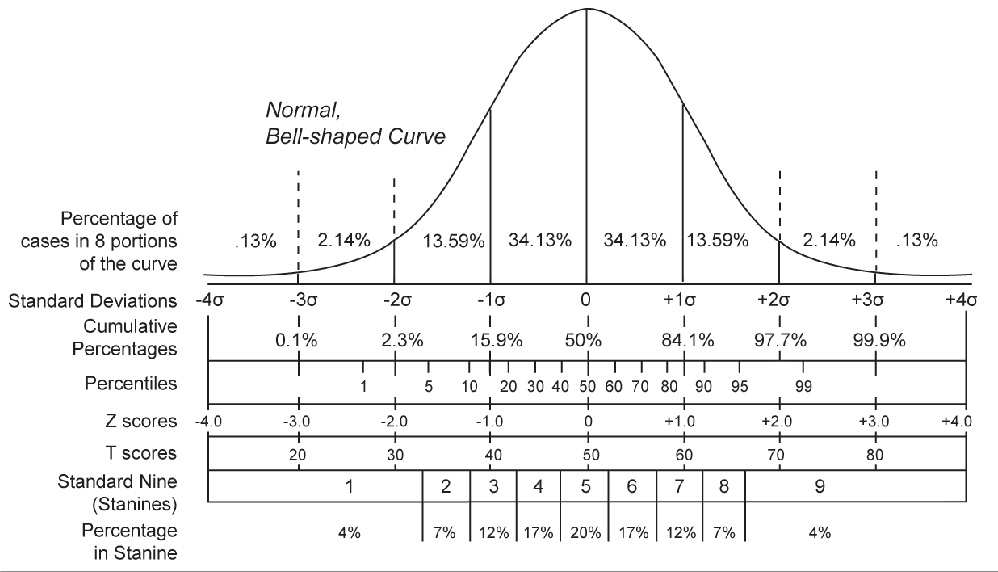Descriptive statistics: Difference between revisions
Jump to navigation
Jump to search
Matt Pijoan (talk | contribs) (Created page with "test") |
|||
| (One intermediate revision by the same user not shown) | |||
| Line 1: | Line 1: | ||
[[Image:Normal distribution and scales.jpg|thumb|350px|right|A graph of a [[Normal distribution|normal bell curve]] showing statistics used in [[standardized testing]] assessment. The scales include ''standard deviations, cumulative percentages, percentile equivalents, Z-scores, T-scores, standard nines,'' and ''percentages in standard nines.'']] | |||
==Measurements of central tendency== | |||
*[[Mean]] In general understanding, the mean is the average. Suppose there are five people. The people have, respectively, 1 TV in their house, 4 TVs, 2 TVs, no TVs and 3 TVs. You would say that the 'mean' number of TVs in the house is 2 (1+4+2+0+3)/5=2. | |||
*[[Median]] The median is the point at which half are above and half are below. In the above example, the median is also 2, because in this group of 5 people, 2 people have more than 2 TVs in their house and 2 people have fewer than 2 TVs in their house. | |||
==Measurements of variation== | |||
*[[Standard deviation]] (SD) is a measure of variation or scatter. The standard deviation does not change with sample size. | |||
* [[Variance]] is the square of the standard deviation: | |||
:<math>s^2</math> | |||
*[[Standard error]] of the mean (SEM) measures the how accurately you know the mean of a population and is always smaller than the SD.<ref name="urlWhat is the difference between standard deviation and standard error of the mean? Which should I show in tables and graphs?">{{cite web |url=http://www1.graphpad.com/faq/viewfaq.cfm?faq=201 |title=What is the difference between "standard deviation" and "standard error of the mean"? Which should I show in tables and graphs? |author= |authorlink= |coauthors= |date= |format= |work= |publisher= |pages= |language= |archiveurl= |archivedate= |quote= |accessdate=2008-09-18}}</ref> The SEM becomes smaller as the sample size increases. The sample standard devision (S) and SEM are related by: | |||
:<math>SE_\bar{x}\ = \frac{s}{\sqrt{n}}</math> | |||
* 95% [[confidence interval]] is <u>+</u> 1.96 * [[standard error]]. | |||
* [[Coefficient of variation]] (CV) is the ratio of the standard deviation <math>\ \sigma </math> to the mean <math>\ \mu </math>, <math>c_{\rm v} = \frac{\sigma}{\mu}.</math><ref name="Campbell Walters Machin p. ">{{cite book | last=Campbell | first=Michael J. | last2=Walters | first2=Stephen John | last3=Machin | first3=David | title=Medical statistics : a textbook for the health sciences | publication-place=Chichester, West Sussex | date=2021 | isbn=978-1-119-42364-5 | oclc=1163960928 | page=}}</ref>. "Commonly, a CV of < 5% is deemed acceptable<ref name="Campbell Walters Machin p. "/>. | |||
==See also== | |||
* [[List of basic statistics topics]] | |||
* [[List of statistical topics]] | |||
* [[Analysis of variance]] (ANOVA) | |||
* [[Central limit theorem]] | |||
* [[Confidence interval]] | |||
==References== | |||
{{reflist|2}} | |||
==External links== | |||
===General sites and organizations=== | |||
* [http://www.amstat.org/ American Statistical Association] | |||
Latest revision as of 03:03, 2 September 2022

Measurements of central tendency
- Mean In general understanding, the mean is the average. Suppose there are five people. The people have, respectively, 1 TV in their house, 4 TVs, 2 TVs, no TVs and 3 TVs. You would say that the 'mean' number of TVs in the house is 2 (1+4+2+0+3)/5=2.
- Median The median is the point at which half are above and half are below. In the above example, the median is also 2, because in this group of 5 people, 2 people have more than 2 TVs in their house and 2 people have fewer than 2 TVs in their house.
Measurements of variation
- Standard deviation (SD) is a measure of variation or scatter. The standard deviation does not change with sample size.
- Variance is the square of the standard deviation:
- <math>s^2</math>
- Standard error of the mean (SEM) measures the how accurately you know the mean of a population and is always smaller than the SD.[1] The SEM becomes smaller as the sample size increases. The sample standard devision (S) and SEM are related by:
- <math>SE_\bar{x}\ = \frac{s}{\sqrt{n}}</math>
- 95% confidence interval is + 1.96 * standard error.
- Coefficient of variation (CV) is the ratio of the standard deviation <math>\ \sigma </math> to the mean <math>\ \mu </math>, <math>c_{\rm v} = \frac{\sigma}{\mu}.</math>[2]. "Commonly, a CV of < 5% is deemed acceptable[2].
See also
- List of basic statistics topics
- List of statistical topics
- Analysis of variance (ANOVA)
- Central limit theorem
- Confidence interval
References
- ↑ "What is the difference between "standard deviation" and "standard error of the mean"? Which should I show in tables and graphs?". Retrieved 2008-09-18.
- ↑ 2.0 2.1 Campbell, Michael J.; Walters, Stephen John; Machin, David (2021). Medical statistics : a textbook for the health sciences. Chichester, West Sussex. ISBN 978-1-119-42364-5. OCLC 1163960928.